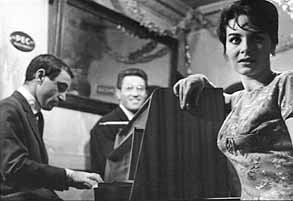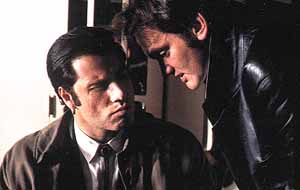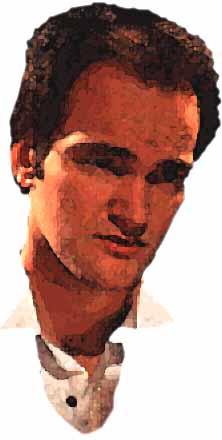|

Francois Truffaut's Shoot the Piano Player
|
Thirty years later, a young Californian was thinking along the same lines. Unlike the eloquent Truffaut, Quentin Tarantino was aspiring to "fuck up the trail of bread crumbs" that American genre films left for viewers to follow. Throughout Reservoir Dogs and especially Pulp Fiction, Tarantino experimented with genre conventions just as Godard and Truffaut had in their earliest films. Unexpected plot twists, unusual dialogue, cinematic in-jokes, and unconventional characters galore became Tarantino trademarks; however, they were trademarks for which he didn't own the copyrights.
For better or for worse, a Tarantino backlash has been in full swing ever since the love affair with Pulp Fiction died down. An iconoclastic 1993 article in Film Threat exposed the similarities between Dogs and the Ringo Lam shoot-em-up City On Fire; other stories have chronicled Tarantino's alleged plagiarism as well as his reluctance to share credit. While not detracting from the brilliance of Tarantino's films, the backlash did manage to put a sizable dent in his armor. To his credit, however, Tarantino gladly admits his influences. He learned to make films by watching them, and he knew only too well how many movies stole from their predecessors (Clarkson, p. 130). His non-linear approach to narrative had been utilized by several noir films from the 1940s and 50s, most notably by Stanley Kubrick's influential 1956 heist film The Killing. Tarantino's use of juke box favorites to punctuate the onscreen action had been realized 20 years earlier by Scorsese in Who's That Knocking At My Door and Mean Streets. Most importantly, however, Tarantino's gleeful and sometimes shocking manipulation of genre film conventions had been explored fully by New Wave films like Truffaut's Shoot The Piano Player and Godard's Band Of Outsiders (original French title: Band A Part, which Tarantino used as the name of this production company). In his efforts to "fuck up the trail of bread crumbs," Tarantino had in fact been following one of his own. One of the paths led him straight to Paris.
|

John Travolta and Quentin Tarantino on the set of Pulp Fiction.
|
Between 1959 and 1965, the crest of the French New Wave, both Godard and Truffaut led the pack in telling old stories in new ways. Needless to say, their whole was greater than the sum of their parts. Godard's early self-reflexive, anti-convention genre pieces such as Breathless, Band of Outsiders, Alphaville, and Crazy Pete led to his later ideological period, where his works made viewers question not only the accepted conventions of genre films, but filmmaking altogether. The more pragmatic Truffaut took an easier, but nevertheless challenging route. From Shoot The Piano Player (1960) to Mississippi Mermaid (1969), Truffaut's work in particular existed against the matrix of genre films and the curious rules that applied to them (Monaco, p. 40). Thirty years later, Tarantino's work seems to imply that he's travelling down the same road that Truffaut did. Reservoir Dogs certainly experimented with the rules, and Pulp Fiction was an all-out attempt by Tarantino to break and then re-assemble the rules in humorous and malignant ways. Both Truffaut and Tarantino construct genre films on their own terms, and both display a steadfast desire to stick to their guns in this respect.
page 1 of 3

|


 The French New Wave of the early 1960s thrived off of the creative tension between past cinema and the fresh innovations of the New Wave directors. If the New Wave was about creating a new kind of cinema, the filmmakers weren't always starting from scratch: rather, they were re-working established elements into a new kind of syntax.
The French New Wave of the early 1960s thrived off of the creative tension between past cinema and the fresh innovations of the New Wave directors. If the New Wave was about creating a new kind of cinema, the filmmakers weren't always starting from scratch: rather, they were re-working established elements into a new kind of syntax.



